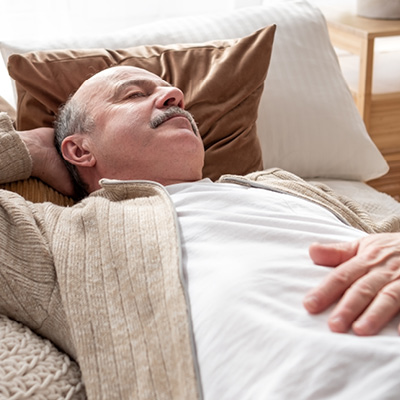Vitality eNews Sign Up
Receive the Summa Health eNewsletter for the latest health tips, advice and updates.
4 Alternatives to CPAP masks to treat sleep apnea
Posted August 30, 2021 by Ketan Deoras, M.D. and Gary Huang, M.D.

It’s estimated about 30 million Americans suffer from sleep apnea, according to the American Sleep Apnea Association. That number, however, continues to rise due to the country’s growing obesity epidemic.
Obstructive sleep apnea (OSA) is a condition that causes your breathing to stop during sleep — sometimes up to several hundred times a night. When you stop breathing, your blood oxygen levels can drop abruptly during the night, which may cause the brain to wake you up to breathe. Daytime symptoms can include fatigue, sleepiness, impaired concentration, and headaches.
Although men are at a higher risk for OSA than women, both sexes can suffer. If you or your partner are suffering from OSA, it is not only frustrating when you’re trying to sleep, but it can be very serious and negatively impact your health.
For many, standard treatment for OSA is use of a CPAP (continuous positive airway pressure) device, which delivers pressurized air into the airway to help keep soft tissues, such as your throat, from collapsing during sleep. CPAP machines can improve your sleep, and lower your risk for heart attacks, heart failure and strokes.
However, for some CPAP machines aren’t effective, or can be uncomfortable for the individual to wear.
The good news is there may be another treatment option. Summa Health reviews 4 alternatives to CPAP masks that may help you get the good night’s rest you require for your health and living a quality life. Talk to your physician to find out if any of these options are right for you.
Positional therapy
You might find relief simply by sleeping on your side because the position can make it easier for air to get to your lungs. There are devices available that attach to your waist or back to help keep you from rolling onto your back in the middle of the night. You could even tape a tennis ball to your back to accomplish the same goal.
Dental appliances
Oral appliances, similar in look and feel to a mouth guard, can be effective in reducing air resistance. The devices, which can be custom fitted by your dentist, can be used to move your jaw forward or hold your tongue in place, which helps prevent the tissues in your throat from collapsing so your airway remains open.
Weight loss and lifestyle changes
Obesity is a major risk factor for OSA, so maintaining an ideal body mass index, healthy diet and exercise regimen is key to warding off — and in some cases, curing — the condition. Weight gain can cause fat tissue to build up around the throat. During sleep, that extra tissue can block your airflow.
In addition, avoiding alcohol and tobacco could help you sleep better at night. Heavy drinking before bed can relax your upper airway muscles and make it harder to breath. Smoking also can worsen OSA by causing inflammation in your airways.
Surgery to fix underlying causes
In some cases, anatomy and genetics may be the problem. For example, if you’re born with large tonsils or extra tissue in your throat, you may have trouble breathing while sleeping. Other issues may involve the tongue, jaw or the soft palate.
If lifestyle changes and other treatments haven’t worked, surgery may be recommended to open up your airways, including:
Tonsillectomy: If your tonsils are enlarged, they may actually obstruct your airway when you lie down and cause you to completely stop breathing in your sleep. Your doctor may recommend a tonsillectomy to help you breathe while sleeping.
Tongue reduction surgery: If you have a large tongue that is blocking your airway while you sleep, surgery to make it smaller can help.
Jaw surgery: Narrow jawbones can be widened, or if you have a shortened upper or lower jawbone, lengthening or moving it forward can create more space for you to breathe.
Nasal surgery: You may need a surgeon to remove polyps or repair a deviated septum to help you breathe more easily through your nose.
Soft palate surgeries: Uvulopalatopharyngoplasty, or UPPP, is a common procedure to remove excess tissue in the back of your mouth and throat to open up your airway. Alternatively, you may benefit from a uvulectomy, which removes all or part of the uvula, the tear-shaped tissue that hangs down in the back of your throat.
For those who have moderate to severe OSA, a minimally invasive surgery, called the INSPIRE procedure, may be a fit. This procedure uses an FDA-approved implantable device to deliver mind stimulation to the hypoglossal nerve to prevent the tongue from blocking the airway.
Though CPAP masks are standard treatment for OSA, they’re not the only option. Be sure to discuss alternative treatments with your doctor so you can get the good night’s rest you deserve to lead a healthy, productive life.
If you’re suffering from a sleep disorder, schedule an appointment with Summa Health’s Sleep Medicine Specialists by calling 330.996.7711.


